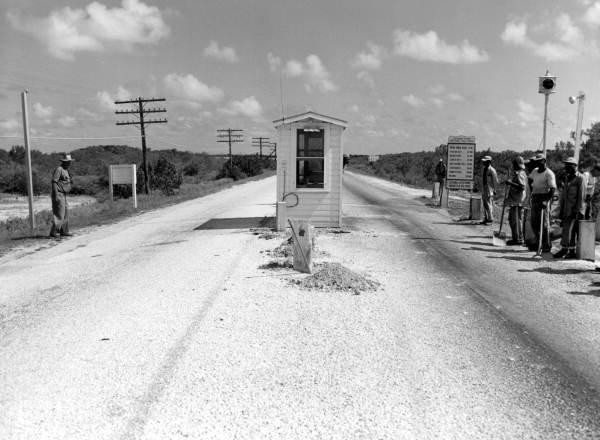What’s old is new again
By Hays Blinckmann & Sara Matthis
Monroe County, the City of Marathon and the Village of Islamorada have signed off on a resolution to explore the idea of a toll on Overseas Highway. It wouldn’t be the first time. From 1938 to 1954, Overseas Highway was officially called the “Overseas Road and Toll District.”
The most complete account of the toll history in the Keys is Jerry Wilkinson’s account: “History of the Overseas Highway,” at www.keyshistory.org. Many of the existing records in the Key West library are fragile sheets of onionskin crowded with typewritten accounting spreadsheets. The Overseas Road and Toll District was first and foremost a boon to the Keys’ tourist industry. Later, it would become a source of scandal when the now-defunct Miami News’ investigative reporting revealed financial discrepancies in the 1950s.
The idea for a toll emerged in 1932, when the island residents longed for more reliable means than the ferry service connecting the islands, especially Key West, and wanted actual roads and bridges throughout the entire island chain.
“Monroe County’s population was mostly in Key West; therefore, for the county to survive, either the railroad or the highway had to exist,” Wilkinson writes.
The roads of Monroe had already been under construction for decades and the costs continued to mount. (In 1917, Monroe County floated a $100,000 bond to build roads, or trails, on Key Largo, Big Pine Key and a bridge from Key West to Stock Island.) The county was already indebted and so the Overseas Highway Bridge Corporation was formed, with a plan to borrow $10.7 million over 19 years. The loan request went all the way to Washington, D.C. but wasn’t approved for some years until the federal Public Works Administration authorized $3.5 million, the balance of the construction costs to be funded with a bond repaid by the road tolls.
“The ‘new’ highway actually had two grand openings in 1938,” said Key West historian Tom Hambright. “The first was in March and the second was in July.” The formal July grand opening was accompanied by a gala weekend, advertised with two-color brochures that featured an Overseas bridge, and a mariachi band on the cover. “And then, there was a third grand opening in 1944 after the U.S. military improved the highway to strengthen the country’s position from Key West during WWII,” Hambright said.
Tolls were a whopping $1 per car — $17.37 in today’s dollars, according to the U.S. Bureau of Labor Statistics – and 25 cents ($4.34 today) for any extra passenger. “The Florida Keys Weekly News of November 1947 listed 15,254 vehicles with tolls of $29,275.25.” Found in the archives of the Key West library, a sheaf of records details tolls in 1948 and one trend still holds true today: February is still the most popular month in the Keys. It details 42,421 “autos,” 4,536 “vehicles” and 90,338 “passengers” passing through and paying revenues of $77,210. The toll booths were located on Big Pine Key and Lower Matecumbe Key. It’s believed that one was to collect northbound tolls and the other the southbound tolls.
The collection of fees was smooth for 15 years. But, in 1953, locals were allowed free passage after some allegations of toll money “misuse,” according to Wilkinson.
According to Hambright, it was alleged the toll funds were being diverted to pay for wild parties on Pigeon Key, the highway’s halfway mark and the headquarters for the Toll and Bridge Commission.
“The radio star Arthur Godfrey would broadcast from Pigeon Key,” said Hambright. “It was rumored that the funds went to buy filet mignon and alcohol for the parties.”
The case was investigated by none less than the governor himself. Charley Eugene Johns, a state senator, became the acting governor upon the death of Gov. Dan McCarthy. According to Hambright, the state handed down an indictment but it’s unclear what happened next other than the end of toll collection. It was completely suspended in April 1954 and the highway name was shortened to “The Overseas Highway.”
The toll idea has resurfaced numerous times since. The first time was just a year later. According to Wilkinson as reported in the Miami News, another toll road from Miami to Key West was proposed, a “super-highway,” with an interesting graduated configuration — six lanes to Key Largo, four lanes to Marathon, and two lanes to Key West.
More recently, it came up in 1990 at the suggestion of the state Department of Natural Resources. It proposed visitor fees of $1 for tourists who fly into the Keys and 50 cents for drivers. It was unanimously struck down by Gov. Bob Martinez’s cabinet, although its lofty goal was to preserve the Keys unique environment.
Currently, there is a thriving debate on what toll revenues can fund. Some say collections can only go to pay for infrastructure, i.e. more roads. Others cite precedents such as Alligator Alley. Toll revenues that exceed road maintenance and construction for Alligator Alley, are being diverted to the South Florida Water Management District’s fund for Everglades reconstruction.
Picture: The Overseas Highway toll booth on Big Pine Key. MONROE COUNTY LIBRARY COLLECTION/Flickr
Card Sound Road Bridge
Card Sound Bridge was constructed in 1928 as a wooden structure. In less than 10 years, it had fallen into such disrepair that it was closed to vehicular traffic. It wouldn’t reopen again until Monroe County issued a $2.6 million bond to rebuild the 65-foot-high structure in 1969.
Islandia
In 1964 there was talk of a toll road to be constructed from mainland Florida to the Keys. This one would have stretched from Key Biscayne to where Ocean Reef is now, and stretch across Elliott Key as its main land mass. (The biggest open water span, between Key Biscayne and Elliott Key, would have required a 10-mile bridge!) The proposed development would have been called “Islandia.” The plan was bandied about for a couple of years with many arguments about whether Monroe County or Dade County would receive the lion’s share of the toll funds before it finally died.
“There was not quite enough water for swimming and too much for farming.” — a quote from a ferry captain on the unreliability of the ferry service, as quoted from Jerry Wilkinson’s “History of the Overseas Highway.”


























